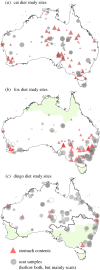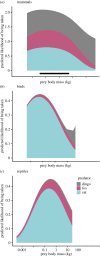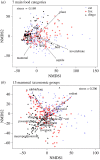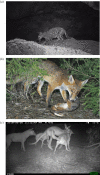Distinctive diets of eutherian predators in Australia
- PMID: 36312571
- PMCID: PMC9554524
- DOI: 10.1098/rsos.220792
Distinctive diets of eutherian predators in Australia
Abstract
Introduction of the domestic cat and red fox has devastated Australian native fauna. We synthesized Australian diet analyses to identify traits of prey species in cat, fox and dingo diets, which prey were more frequent or distinctive to the diet of each predator, and quantified dietary overlap. Nearly half (45%) of all Australian terrestrial mammal, bird and reptile species occurred in the diets of one or more predators. Cat and dingo diets overlapped least (0.64 ± 0.27, n = 24 location/time points) and cat diet changed little over 55 years of study. Cats were more likely to have eaten birds, reptiles and small mammals than foxes or dingoes. Dingo diet remained constant over 53 years and constituted the largest mammal, bird and reptile prey species, including more macropods/potoroids, wombats, monotremes and bandicoots/bilbies than cats or foxes. Fox diet had greater overlap with both cats (0.79 ± 0.20, n = 37) and dingoes (0.73 ± 0.21, n = 42), fewer distinctive items (plant material, possums/gliders) and significant spatial and temporal heterogeneity over 69 years, suggesting the opportunity for prey switching (especially of mammal prey) to mitigate competition. Our study reinforced concerns about mesopredator impacts upon scarce/threatened species and the need to control foxes and cats for fauna conservation. However, extensive dietary overlap and opportunism, as well as low incidence of mesopredators in dingo diets, precluded resolution of the debate about possible dingo suppression of foxes and cats.
Keywords: Canis familiaris; Felis catus; Vulpes vulpes; invasive species; niche separation; resource partitioning.
© 2022 The Authors.
Conflict of interest statement
None of the authors have a conflict of interest to declare.
Figures








References
-
- Woinarski JCZ, Burbidge AA, Harrison PL. 2014. The Action Plan for Australian Mammals 2012. Collingwood, Victoria: CSIRO Publishing.
-
- Woinarski JCZ, et al. 2019. Reading the black book: the number, timing, distribution and causes of listed extinctions in Australia. Biol. Cons. 239, 108261. (10.1016/j.biocon.2019.108261) - DOI
Publication types
Associated data
LinkOut - more resources
Full Text Sources
Miscellaneous

